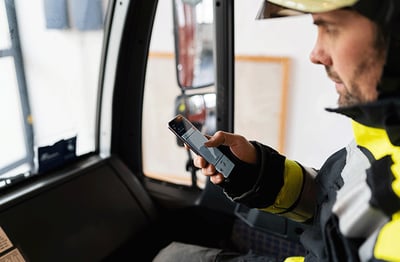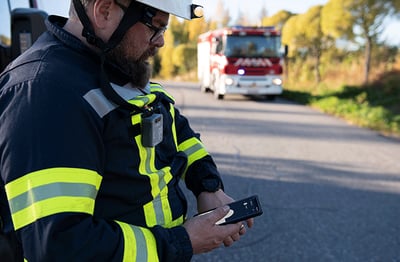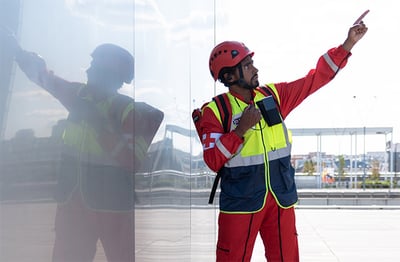As a mission-critical user, you do not want your devices to run out of battery in critical situations. But what do you need to know about battery life before bringing smartphones or hybrid devices into professional use? What are the most important smartphone battery requirements? There are five essential things you’ll want to consider.
When you need to keep smartphone charged and ready to go at all times, take note of the answers to the following five questions:
- How to keep the batteries powered up?
- Can the battery be changed?
- Are portable power banks safe to use?
- What is the power consumption?
- What is the real cost?
1. How can batteries be kept powered up?
Public safety users such as police officers are constantly on the move, making it difficult to keep their mission-critical devices powered up at all times.
Typically, a police officer, for example, carries a mission-critical radio, a smartphone and a body worn camera. Although it’s good to carry both a radio and a smartphone as backups for each other, each device has a different kind of battery and charger and will run out of power at different times.
Charging can be frustrating and time consuming, leading to additional devices or batteries being left uncharged.

The advantage of having just a smartphone or a hybrid device that combines both professional radio and broadband is that there’s only one battery to charge.
Some devices, such as Tactilon Dabat, also enable quick and easy charging – you can quickly remove the device from your uniform using an express strap, put it into the battery charging station in your vehicle, fast charge the device, and place it back onto your uniform.
2. Does the device have a removable battery?
As a mission-critical user, you may often find yourself running out of battery with no time to charge it.
Ideally, the battery of your duty smart or hybrid device should last an entire work shift. But if it runs out of power, it should be quick and easy to change.
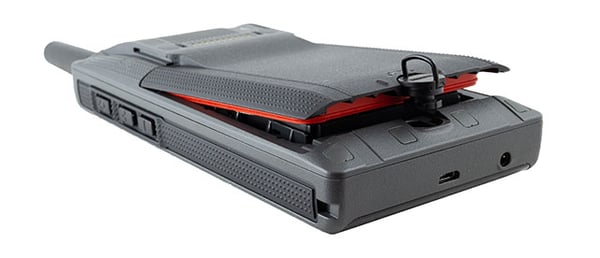
Smartphones mostly come with non-removable batteries, but some smart or hybrid devices have a removable battery – if it does, how quickly and easily can you replace the battery with a charged one?
There are devices, such as Tactilon Dabat, that let you easily change the battery quickly on the go, making it ready for use in no time.
3. Are power banks safe to use?
Portable power banks are widely used by consumers and many professional users are also thinking of using them.
But which power bank will meet your professional requirements and not damage your battery? Here are five tips that will help you make the right choice:
- The power bank should have a CE label/certification and come with an EU Declaration of Conformity Document.
- Li-ion power banks for EU markets should have battery cells certified according to IEC 62133.
- The power bank should have built-in safety circuits to protect the user from over charge and short circuits.
- The power bank should be robust. Typically, this is indicated with terms such as shockproof, waterproof, drop-resistant and with MIL-STD-810G certification.
- The power bank’s mAh capacity should be twice as large as needed. A typical power bank only provides 50-60% of the energy needed to charge your mobile device. This means if your duty smart or hybrid device’s battery capacity is 5000 mAh, the power bank’s capacity needs to be 10,000 mAh.
Also, to avoid damaging batteries, always charge them at room temperature and don’t leave them unattended.
4. What about power consumption?
Mission-critical users use their devices in ways that can shorten the time the battery can provide power. There are many ways to extend the battery life for your duty smartphone, but making use of them, ask yourself:
Does the device come with an integrated GPS-receiver?
A smartphone or hybrid device with an integrated GPS receiver consumes much less power than a separate GPS receiver.
For example, a video sharing app could allow you to share map coordinates of the video shoot. The GPS part of the map app consumes much less power, so when you are not using maps, the GPS could stay on in the background.
Does the device have an energy saving function?
Check if your duty smart or hybrid device can go into an energy saving mode when idle, without compromising the availability of services.
This automatically minimizes network use and other resource-intensive services for as long as your device stays idle.
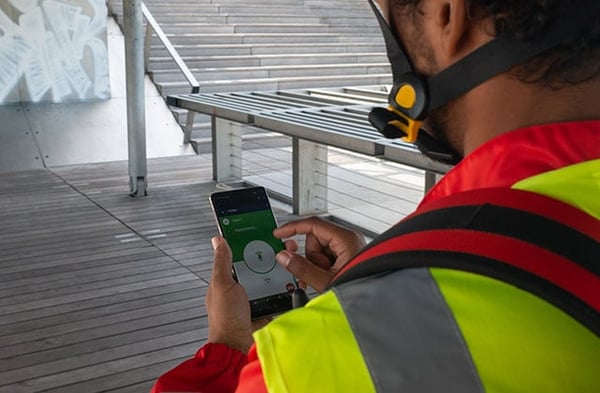
How can power consumption be optimized when using both TETRA and LTE?
If your organization is using both TETRA and LTE for your critical communications, check if there’s a way to optimize their power consumption.
In a hybrid device such as Tactilon Dabat, the Hybrid Roaming solution will automatically switch between TETRA or LTE/Wi-Fi depending on what's available. The user can optimize battery power by selecting to use LTE, or better yet WiFi, as they both consume less battery power compared to TETRA.
If the user has both a TETRA radio and a smartphone, optimizing power consumption is not so straightforward. The user must choose which device to use, basing their decision on which battery runs out quicker.
Handpicked related content
What does "hybrid device" really mean? Check the blog post “This is what professionals really want to know about hybrid devices”.
Does the device support Wi-Fi?
If you work indoors, check if your duty smart or hybrid device supports Wi-Fi.
If it does, it’s possible to configure your device to switch from 3G/4G and/or TETRA to Wi-Fi, which can allow you to work for up to one week indoors, without charging the device. This compares to using 3G/4G, where the device can work for a few days without charging, or TETRA only, where the battery may last only one day.
Better yet, if the device offers an Application Programming Interface (API), it would be possible to always turn off TETRA, and turn it back on when there’s no Wi-Fi or 3G/4G available.
5. What is the real price tag?
Last but not least, when bringing smart or hybrid devices into professional use, it’s important to look beyond the purchase price.
Smart or hybrid devices may seem a ”cheap” solution, but buying chargers, battery charging stations, extra batteries, installation, maintenance, and repair separately can triple the original purchase price. So, to avoid unpleasant surprises, check what the price tag actually includes and what it doesn’t.
Because your professional communication device is your lifeline in critical situations, It has to be secure. Minimize your risks and download the white paper "How to manage smartphone risks for professional users" –
When you have mission-critical broadband and can adopt smart devices for your critical operations, it is important to learn “The first things you need to know when your organization wants to adopt mission-critical smartphones and apps”.
This was the third in a series of blog posts on adopting mission-critical smartphones and apps.
The first blog post in the series tackled the question: How can we manage smart and hybrid devices, as well as the apps that bring them to life? And the second blog post tackled the question: How to use TETRA and smartphones in a hybrid way?
Editor's note: This blog post was first published in October 2019 and it has since been updated with links to relevant information that was published later.


